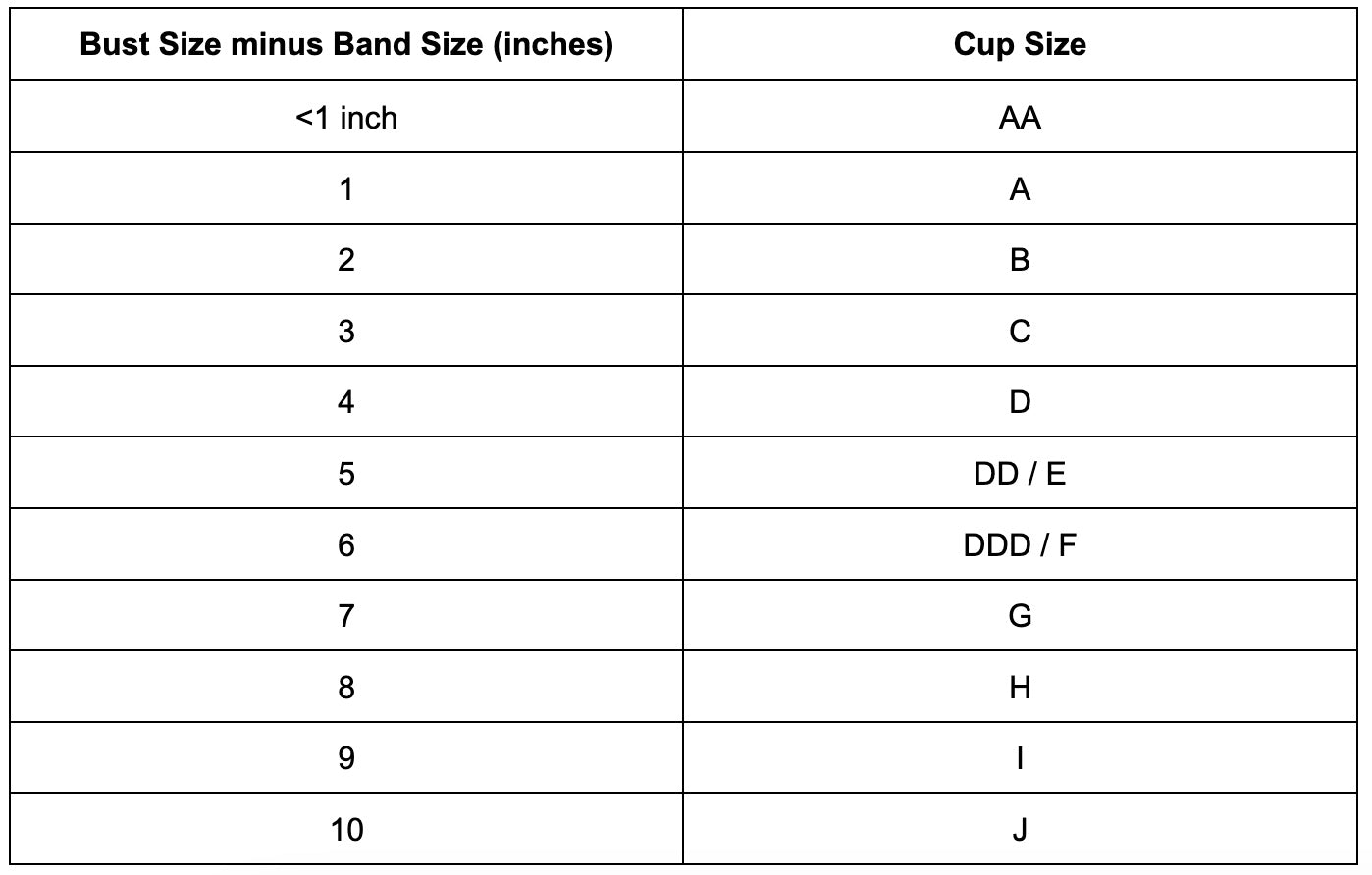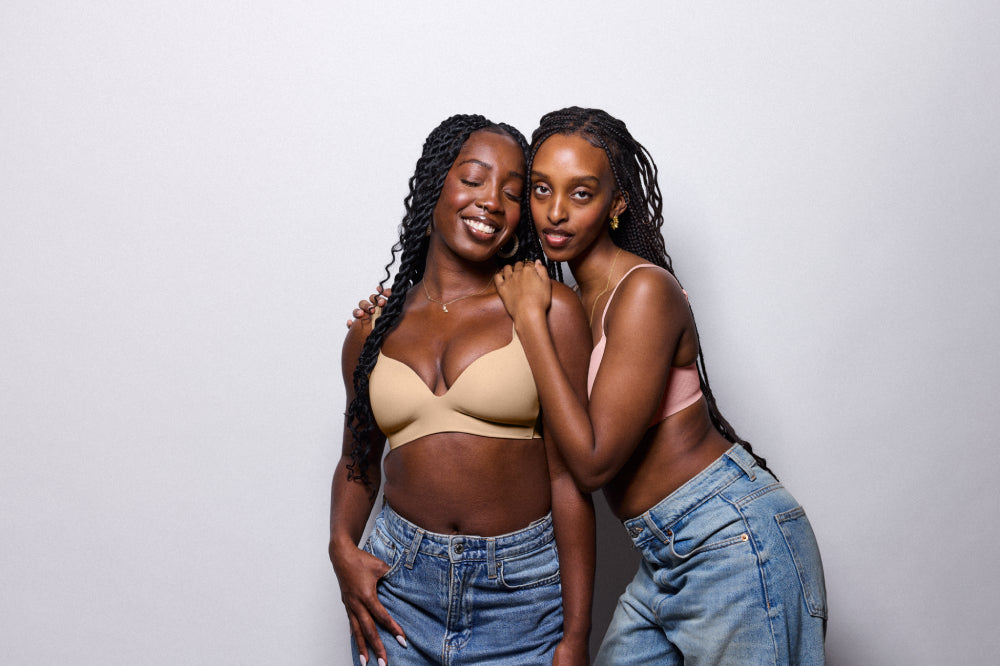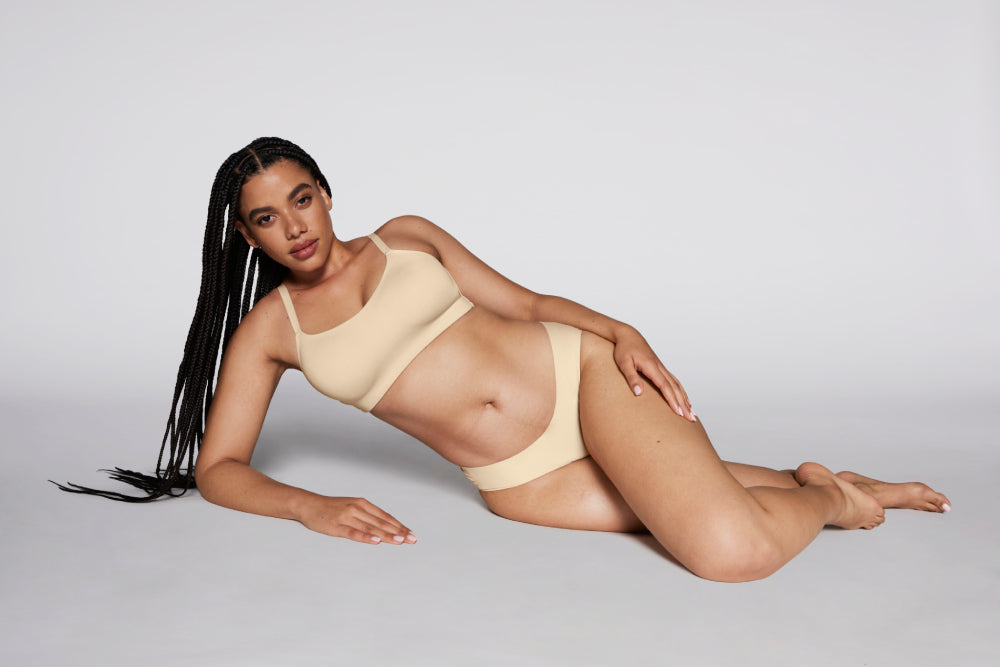How to Measure Bra Size: Everything You Need to Know
It’s said that a whopping 80% of women wear the wrong size bra. This stat seems designed to have us all running to the closest lingerie shop, or at least reaching for the measuring tape.
But this popular stat is misleading: It implies that there’s an objective “Right Size” for everyone. This is no more true of bra sizing than it is for any other item of clothing.
That’s right — and it’s absolutely not fair — but there is no universal standard of bra fitting across brands, any more than there is of jeans or t-shirts or any other item of clothing.
However, learning the ways (yes, there are multiple ways) you can measure bra size can help you start in a better place when you’re shopping for bras. It’s worth understanding the approaches to how to measure bra size so you can make sense of the number.
However, at the end of the day, numbers are just that. What you should really care about when it comes to bras (and other clothing for that matter) is good fit for your body.
Bra Size and Bra Fit Are Different
A reminder then, that although bra size and bra fit are connected, they are also different. A pair of jeans can be the right size, but if they gape at the back when you squat, or leave red marks around your waist, it’s a good indication that they’re not fitting you well.
Bra fit goes beyond size because it considers comfort and wearability. And as any woman will attest, a bra might be the right size, but it might not fit well.
Signs You’re Wearing the Wrong Bra Size
If you’re wearing an ill-fitting bra, you’ll probably be very aware of it because you won’t feel supported, comfortable, or have the shape you want.
Here are some of the giveaways that your bra is the wrong fit for you:
- Your straps slide off your shoulders, even after you’ve tightened them
- You shift around in your cups
- Your breasts bulge out of your cup or sides
- The band rides up your back
- The underwire hurts your ribcage
- Your bra leaves painful marks on your skin
- You’re plain uncomfortable
If a bra isn’t fitting you well there could be two culprits:
- The wrong bra size
- The wrong fit or style of bra for your body
First, you’ll want to rule out the size being the culprit. Now, while we recommend getting fitted for bras (either virtually or in-person), we will share the traditional explanation of how you measure yourself for a bra. We’ll also explain why this is not always a trustworthy method when it comes to shopping for bras.
The (Unreliable) Traditional Method of Measuring Bra Size
Okay, so how to measure bra size? There’s absolutely no harm in whipping out a tape measure and seeing what bra size you come up with for yourself. But consider the result a “jumping off point” rather than a conclusive, forever answer about what size bra you should wear.
Bra sizes are always made up of a number and letters, 32D, 36C, 34E, and so forth… The number part is your band size and the letter indicates your cup size.
Here’s how you measure your bra size: First, you’ll want to strip down. Either go bare or wear an unlined/unpadded bra that keeps your natural shape (i.e. not push-up).
First, Measure Your Bra Band Size
Get your band size by using a (flexible, sewing) measuring tape to measure around your torso directly under your bust, where a bra band would sit.
Remember the idea is that you get most of your support from the underwire or band rather than all the support coming from your shoulders (ouch!) So, the tape should be level and snug beneath your bust, parallel to the ground. The measurement in inches is your “band size”, according to this method.
Let’s say you measured 34 for your band size, then your bra size starts with 34.
If the number you measure for your band size is odd or a fraction, round up to the nearest even number. E.g. if you measure 33 or 33.5, round up to 34.
Then, Measure Your Bust Measurement to Get Your Cup Size
The second measurement you need to take doesn’t appear in the bra size, but it is used to calculate the cup size. It's your bust measurement.
So, now, using the same measuring tape, measure around the fullest part of your bust. If your breasts are fuller at the bottom, it may be easier to lean forward from the waist when you measure the fullest part. You’ll want to try to have the tape run parallel to where it sat when you measured your band.
Let’s say you measured 38 here.
Finally, Calculate Your Cup Size Using a Bra Size Chart
Now, to calculate your cup size, you’ll subtract your band size from your bust size. Each inch represents a cup size, as shown in the bra size chart below.
For our example, that’s 38 minus 34, which is 4.
4 inches is a D cup size.
So the bra size according to this method is 34D.

As you shop for bras or attend fittings, you may notice your bra size goes up and down as you shop across brands. In part, this is because this traditional method isn’t really standard.
Where it Gets Complicated: Bra Band Size Plus # Inches
The three steps above make it seem fairly straightforward, right? Well, that’s where we’ve all been misled.
Here’s the truth. Not all brands size bras this way. Some of the different approaches include:
- Measuring the band size under the arms instead of under the bust.
- Measuring the band size under the bust, but adding anywhere between 2 and 5 inches to that number.
Now, you can find whole Reddit threads debating the “right” way to measure your bra. But at the end of the day, unless you’re making your own bras, it doesn’t really matter. What you, as a consumer, need to understand is that you can’t really trust the numbers alone.
This doesn’t mean a brand is “right” or “wrong” just that their approach to design is different. That’s why it’s ultimately recommended that you get fitted for bras. And although many women feel that this will be an awkward or uncomfortable experience, in our experience it’s actually uplifting (pun intended) to find the right fit for your body.
Even if it causes you a flash of anxiety, weigh that against the discomfort and expense of wearing the wrong size bra.
What Has Breast Shape Got to Do With the Right Bra Size?
Even if you had a consistent bra size across every brand, it wouldn’t mean that every bra is right for you. That’s because we’re all shaped differently.
Let’s go back to jeans for a little analogy: Three women might be a size 29 in jeans, but they might all have very different body shapes, tall, thin, short, athletic… whatever. This will mean even though they could all wear the same jeans, odds are they’ll look and feel better in different styles. One woman might choose skinny jeans, another might prefer a flare or boyfriend cut. You get the gist...
After years of reading women’s magazines and hearing women’s bodies described, we’re all generally very aware of our body shape. But we often aren’t as aware of our breast shape and what breast shape means when we’re looking for the right fit bra.
Let’s look at some of the different breast shapes:
- Full, round breasts
- Compact, high or athletic breasts
- Bell or teardrop-shaped breasts
- Wide-set or “east-west” breasts
- Asymmetric breasts
A note on asymmetry: No one’s breasts are identical twins. Odds are one breast will be slightly larger than the other (one of your feet is probably slightly larger than the other too!)
Also, it’s important to note that you might not sit neatly in one of these shape categories. As with body shape, we’re all different. This is exactly why it can be so challenging to find the right fit — and why you might need some help!
You may also want to read our article: How to find the right bra size
Resources to Help Measure Your Bra Size
We realize that if you were looking for an easy answer to this question, we’ve probably disappointed you. However, it’s really important to understand the complexities of bra-sizing and fit when shopping so that you can get the comfort you deserve, and avoid costly mistakes.
The wrong size or fit of bra can ruin your day. You’ll feel uncomfortable, maybe even sore, and just want to get home so you can rip the damn thing off.
As an online retailer, we know it can be especially daunting to make a bra purchase online. That’s why we developed our virtual fit program to help measure your bra size. Learn more about it today and book your appointment!
What to Expect from a Knix Virtual Fitting:
- Book your virtual fitting
- We’ll connect you with one of our expert Knix team members for a 1-on-1 fitting session over video chat.
- For your bra fitting, we recommend you wear a bra with little or no padding and a fitted t-shirt to make sure we get an accurate measurement. You’ll also need either a) a soft measuring tape or b) a piece of string or cord and a tape measure or ruler.
- With different styles and sizes for 30A to 42G in the world’s most comfortable and supportive wireless bras, our fit experts can help you get into something that you will love to wear every single day.
How to Wear a Bra
When you get a new bra, whether it’s one you ordered online or one you purchased in store, there are some notes on how you should put it on and wear it to begin.
For Knix bras in particular, they’re designed to feel a little snug when you first wear them, but relax with wash and wear.
When trying on bras, always fasten the bra on the loosest hook. Bras will stretch out over time, so you want to use the last hook to begin so that you can continue to tighten as the bra wears and loses elasticity.
Next, adjust the shoulder straps to ensure they’re tight. Relax your shoulders, shrug and move to ensure the straps stay put when you move about. If they slide off your shoulders you might need a bra design that has closer set shoulder straps, or you might need to revisit sizing.
If the bra is underwired, check to see if the center gore is sitting flat against your chest. If it’s not or you can stick a finger beneath the gore easily, the bra is not fitting you well (note: for non-underwired bras, the gore doesn’t sit flat). Also, raise your arms to make sure your breasts stay put when you move about.
Lastly, look at yourself sideways in the mirror to note where your breasts are sitting. You might also want to try on a tight-fitting t-shirt to ensure your silhouette is smooth.
Even after you’ve found your perfect bra, you should continue checking your size every time you buy a bra (or yearly). Your bust size can change over the course of your monthly menstrual cycle. But you can also go up or down a bra size depending on exercise levels, aging, pregnancy, and weight gain or loss.
FAQs
How Do I Measure My Bra Size at Home?
To measure your bra size at home, start with a soft tape measure. Make sure you aren't wearing a non padded bra or remove your bra all together. Wrap the measuring tape around your torso, under your bust to find your bra band size. The measurement in inches is your band size.
To find your bust measurement, wrap the measuring tape around the fullest part of your bust. Now, to calculate your cup size, you’ll subtract your band size from your bust size. Each inch represents a cup size, as shown in the bra size chart.
How Do You Know Your Bra Cup Size?
You can find your bra cup size by using a bra size calculator or by getting a bra fitting. You can calculate your bra size at home by subtracting your band size from your bust size.
How Do You Know if Your Bra Fits?
Your bra may not be fitting properly if there are gaping cups or if your bra straps are consistently sliding off your shoulders. Using bra size calculators is not always the most effective way to ensure that you find the right fit since sizing can be quite different between brands.










